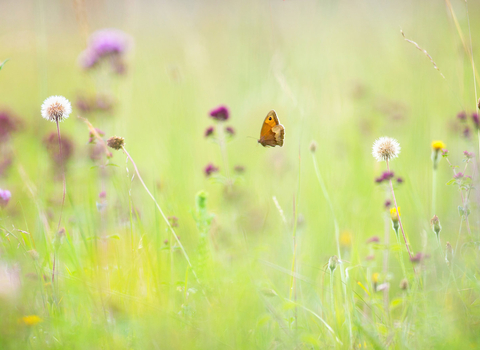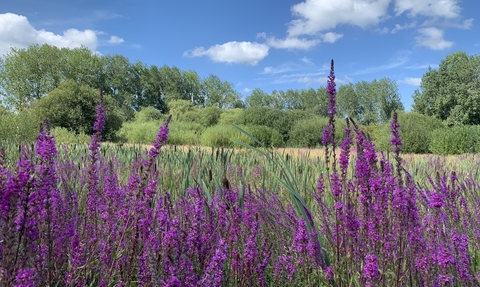
SWT Victoria Bunter
Stafford Brooks
Project updates
This project will continue until all of the site improvements have been completed. As the project progresses we’ll update the section below with the latest project news.
If you have any questions, please email us at staffordbrooks@staffs-wildlife.org.uk, or leave us a message with The Wolseley Centre Reception Team at 01889 880100 and we will get back to you.
17 December 2025 - Seed sowing at Corporation Street Former Bowling Green
This December our project team was out preparing an area of former bowling green to transform it into a wildflower meadow. The ground was harrowed, or prepared, with intense raking to break open the soil ready for planting. We then spread native wildflower seeds over the area.
Most lowland wildflower meadows take about five or more years to fully develop. However, we will start to see some of the faster-growing flowers, like oxeye daisies, as early as next summer. These flowers grow quickly, and the one pictured below was only planted at the former tennis courts in Littleworth earlier this year.
By transforming this area into a lowland wildflower meadow, we'll give a boost to bees and butterflies and bring some colour to this green space for local residents to enjoy!
Stafford Borough Council will continue regular maintenance of this space, but their mowing schedule will leave some extra time for the flowers to grow and make seeds during the summer months, May - July. This ensures a continued lifecycle of flowers for the following year.
We'll be popping by to check how the meadow is getting on, but we'd love to see your photos of any new flowers next summer.
You can send them to staffordbrooks@staffs-wildlife.org.uk

SWT Victoria Bunter

With thanks to Naturescape

With thanks to Naturescape

With thanks to Naturescape

With thanks to Naturescape
07 November 2025 - Planning notice for work at Doxey Marshes
Exciting news! We're in the process of planning improvement works on the River Sow and its floodplain, at Doxey Marshes as part of our expanding programme of works in Stafford.
Please find attached our works announcement which will be post physically around Doxey in the coming week as well as in local publications soon.
These plans will enhance the ground nesting bird habitat at Doxey Marshes through increasing the length of time water is held in the floodplain, without changing flood risk in the surrounding area. The removal of artificial embankments along the river and the creation of riffles in the channel will allow for better movement of water across the floodplain connecting the floodplain and river. Riffles are created through adding gravels into the river channel, the shape and mix of the gravels hold back some water while a shallow flow of water bubbles over the gravels which is great for fish and aquatic invertebrates. Also included are ditch excavations where some ditches are widened to hold more water in targeted locations. The spoil from the excavations is planned to be used within the existing pools to create new shallow wading bird habitat and reinstate the bund in front of the bird hide.
This work is in collaboration with the Environment Agency.
Notice of Development

SWT
25 September - Works complete at Kingston Pool Covert South
We have another success in restoring the watery habitats of Stafford. On 15 September work began in the Staffordshire Borough Council owned woodland south of Weston Road to improve the wet woodland characteristics and increase the biodiversity potential of Kingston Brook. The work is now finished. Our contractors, Caddis Ltd. have brought Dynamic Rivers’ designs to life on the ground with our coordination. The work has been funded and permitted by the Environment Agency.
The woodland was opened to allow access routes for the 13 tonne excavator to complete the works. The brook itself is classified as a main river, and work along it consisted of an excavation out from the channel into the floodplain and inserting gravels into the channel to create two riffles. Riffles are where water has a shallow flow over rocks and pebbles, the turbulence created as the water bubbles over stones adds oxygen for aquatic plants and wildlife.
Some of the water is now filtering through the woodland floodplain, flowing from the fingers of the chute and creating the new wetland areas you can see from the access routes. Our hope is that the existing sedge wetland will expand into these areas and that it will stay too wet for Himalayan balsam.
This work follows on and connects with work finished in March in the community own woodland north of Weston Road as the riffles will raise the brook water level upstream an encourage more water into the widening.
It’s very exciting to finish the whole scheme of works along Kingston Brook as it has been a project with difficult access challenges, soft ground, and seasonal weather considerations. However the Nature Recovery Network along the brook is looking all the better for it!

SWT Thea Margetts

SWT Thea Margetts

SWT Thea Margetts
04 September 2025 - Work at Kingston Pool Covert South
This month we're starting work on the Southern portion of Kingston Pool Covert which is owned by Stafford Borough Council. We are aiming for a start date of 15 September 2025. But this will be weather dependant.
Read below our FAQs:
What work are you doing at Kingston Pool Covert South?
The work planned in the southern woodland is to excavate a connection between the brook and floodplain to aid the development of wet woodland plant life. We will create a chute (a narrow channel for flowing water) and add riffles (deposits of gravel).
The chute will function with natural stream processes, varying in water level with the brook and provide a new habitat for invertebrates. The riffles change the dynamics of the brook, creating a shallow area where the water bubbles over the gravels, this increases the oxygen in the water and creates a new habitat type in the stream.
The work is funded by the Environment Agency and has been subject to Flood Risk Activity Permitting, meaning we had to prove the work will not affect flood risk and will have an overall positive impact on the environment even if there is a short time of disturbance during construction.
When is the work happening? / How long will the work take?
The work is set to begin on Wednesday15 September. However, this work may need to be split into two parts during September. The work will start by establishing access to the brook and excavating a chute that better connects the floodplain and brook. The second stage will be confirmed after the ground has proven stable enough to complete the works. We also will organise around the delivery date of the gravels which are needed to construct the riffles.
We aim to have the work completed by the end of September. The contractors will be actively working in the woodland for 5-10 days.
Can I visit the wood during the works?
The footpath through the woodland will remain open during the completion of the works, however there may be short times of disturbance as machinery needs to move materials to the brook and enters or exits the woodland. Please be respectful to the contractors and follow their instructions for your own safety.
Why are you cutting trees?
We need to cut a few trees in order to get safe access to the woodland to do the conservation work. We have scheduled the works for outside of bird nesting season and have surveyed the trees for bats and birds before beginning. All tree material will remain in the woodland as part of a new habitat here.
How will this benefit wildlife?
Wet woodlands are UK priority habitats, meaning they are designated as important homes for a large variety of species. The work also creates new habitats that are important for wetland invertebrates. This in turn will invite other species to call this place home, such as bats and birds.
How long will it take for the conservation benefits to take effect?
While the work is happening, and in the weeks after, the site may look to have had a dramatic change with bare earth in some areas. This is temporary. Nature will soon do what nature does best, and within a few weeks different species of ground flora will begin to naturally re grow.
Each year the habitat will develop further, but we expect to start seeing the full benefits for wildlife in 2026. This may vary slightly depending on seasonal weather patterns.
11 July 2025 - Summer progress for Stafford Brooks
Senior Marketing and Communications Officer, Christine Harding brings you the latest progress update on Stafford Brooks a year after the first pond was dug at Radford Meadows.
Read the full blog to see how our newest ponds and wildflower meadows are coming along in their first year of establishment.
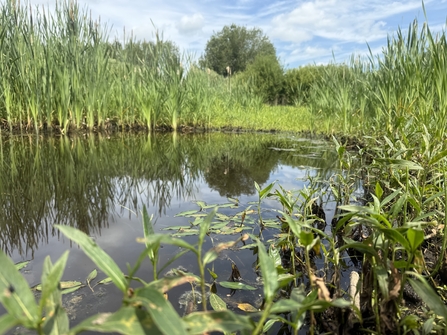
SWT Victoria Bunter
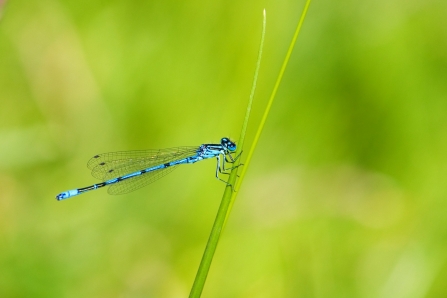
7 May 2025 - Seed sowing at Littleworth former tennis courts
On Wednesday 7 May, our Stafford Brooks project team prepared the ground and planted wildflower seeds at the former Littleworth tennis courts in Stafford.
The meadow we plant here, makes up part of Stafford's Nature Recovery Network along with the other areas in the Stafford Brooks programme. By encouraging healthier habitats along our riverways and green corridors, we're making it easier for wildlife to flourish. This helps to support larger populations of pollinators and other species using these habitats, making them more resilient to extreme weather events we see as part of the climate crisis.
Have a look at the wildflowers we planted and read the full update in our latest blog.
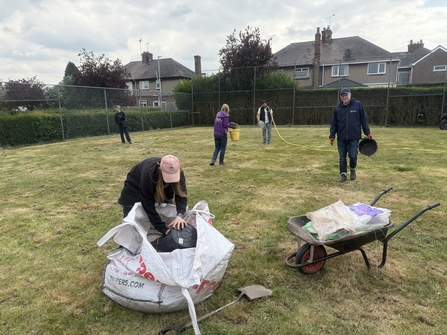
Victoria Bunter
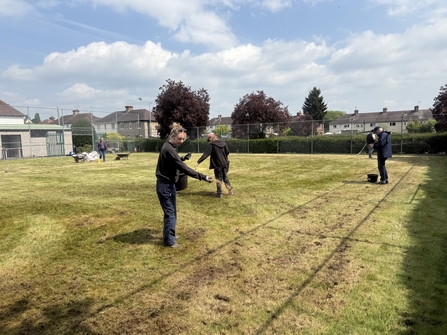
Victoria Bunter
19 March 2025 - Progress at Kingston Pool Covert North
Conservation work was carried out at Kingston Pool Covert North in Stafford thanks to funding from the Environment Agency.
The confluence of the brook was widened to increase habitat size, creating more resting space for juvenile fish, and supporting aquatic invertebrates.
Three woodland ponds were also created, enhancing the wet woodland habitat to encourage more wet woodland plants to establish, habitat for dragonflies, and even bats who will be drawn to the pools to feed.
The ground looks quite raw at the moment, but the plant life will soon start to re-establish with the spring weather, and we cannot wait to see the benefits that it will bring to wildlife. Long term, we hope these interventions may lead to increased visits from otters.
You can read more about this work in the 24 January 2025 update below.
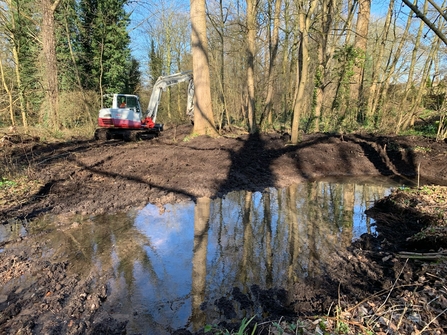
A freshly created woodland pond, photo by SWT Thea Margetts
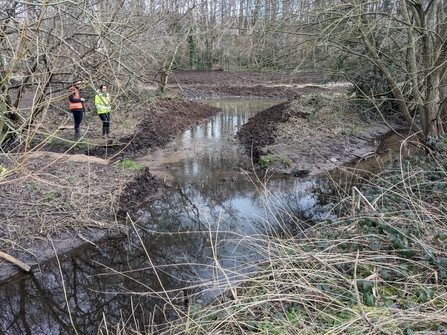
Staffordshire Wildlife Trust Living Floodplains Manager and The Environment Agency Catchment Co-ordinator for Staffordshire Trent Valley, inspect the confluence widening, photo by SWT Christine Harding
28 February 2025 - Works starting at Kingston Pool Covert North
After much preparation, and a visit to Kingston Pool Covert North Ltd.'s AGM on 26 February, we're ready to begin work at Kingston Pool Covert (North)!
This portion of the work, funded by the Environment Agency, will start on Monday, 3 March when our contractor will be onsite setting up his workspace. Our ecologist will also be there, doing the necessary preliminary checks for birds and other wildlife. We will also be putting up safety signage.
Please follow all safety signage, and avoid commuting through the woodland during the works which will last several weeks.
On the Tuesday, works will begin shortly after 9am to allow children time to get to school. But please note that while works are active our banksman may ask walkers to take another route as opposed to going through the woodland.
We will first start with the work widening the confluence. This is the part of the site closest to Gladstone Way. Exact time scales will depend on weather and ground conditions.
If you have any questions, please get in touch with us at staffordbrook@staffs-wildlife.org.uk.
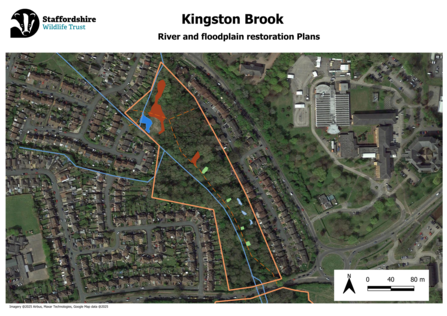
SWT
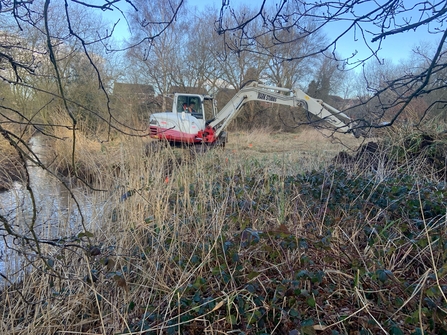
SWT, Living Floodplains Officer Thea Margetts documents confluence widening work at Kingston Pool Covert North Ltd. on 12 March 2025.
24 January 2025 - Important work for wetland wildlife in Stafford's fluctuating floodplains continues - Kingston Pool Covert North
Exciting news! With supplemental funding from the Environment Agency we're doing more work along Stafford's brooks.
Read our latest blog from Living Floodplains Officer, Thea Margetts, and learn all about the conservation interventions we'll make along Kingston Brook for insects, birds, bats, and amphibians.
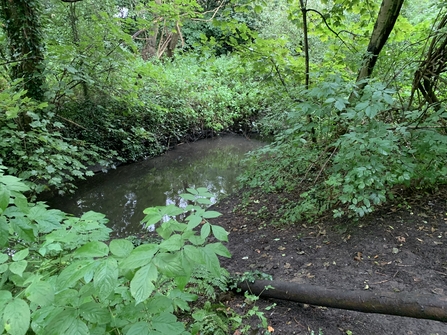
SWT Victoria Bunter
27 November 2024 - Tree Planting for #NationalTreeWeek
It’s #NationalTreeWeek and our project team and wonderful Wildlife Trust volunteers are hard at work out planting Trees for the Stafford Brooks programme!
Believe it or not, just planting loads of trees isn’t as good for the environment as you might think. It’s important to get the Right Tree in the Right Place.
At Rising Brook, we’re planting a variety of several hundred native trees that will thrive in both the wet and drier parts of this woodland. For example trees like alder and willow are often found near streams and rivers, and will cope best in the part of the land here that slopes closer to the water, while trees like black thorn are planted higher up.
By planting trees in the cooler, wet weather in late November, they’ll have the best chance to take root and survive for years to come.
If you'd like to plant trees in your area, we recommend you have a look at our Right Tree, Right Place webpage, which include free reference materials on what species of trees are appropriate for different habitats (for example woodlands, or floodplains) as well as a list of trees native to Staffordshire. There's also a step-by-step planting guide and top tips for after planting care. So don't delay, plan to plant your tree today!
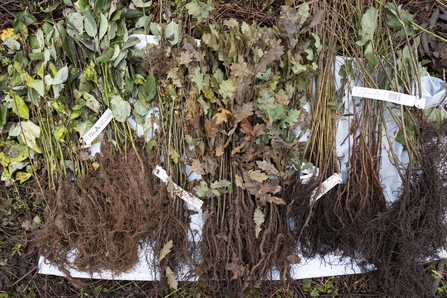
SWT Christine Novelli Harding
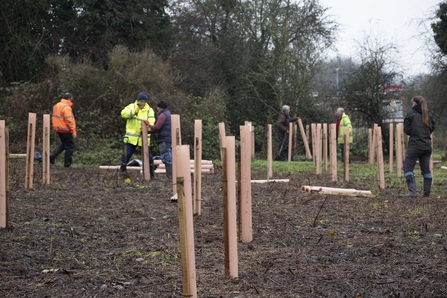
SWT Christine Novelli Harding
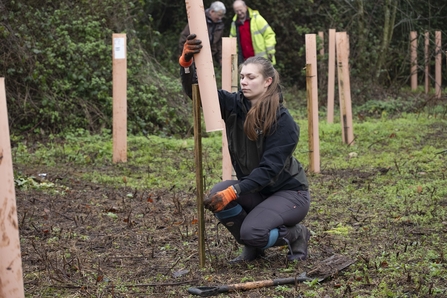
SWT Christine Novelli Harding
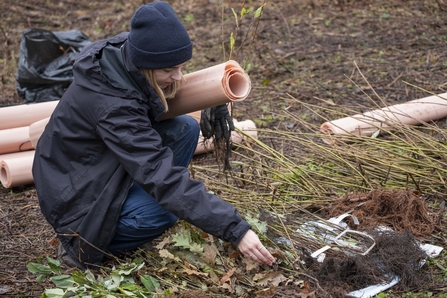
SWT Christine Novelli Harding
03 September 2024 - Project update blog: It's time to set seed
Work continues on the Stafford Brooks project as the conservation begins to enter the next phase. Senior Marketing and Communications Officer Christine Harding brings us up to speed on recent achievements.
Read the full update here.
SWT Rob Woodhouse
02 August 2024 - Project update blog: Make hay while the sun shines...and ponds!
July 2024 has been an important month for Stafford Brooks, with the delivery phase of the conservation work taking off at full speed, and as the old adage goes you need to “make hay while the sun shines.”
SWT Rob Woodhouse
8 July 2024 - Works start, schedule of works requiring machinery
With the arrival of the sunshine, and completion of bird nesting surveys, our contractors Catchment Designs have arrived at Radford Meadows and work is about to begin.
Over the next couple months, conservation work will take place on eight sites throughout Stafford. Below there is an estimated schedule for sites that require bigger machinery to complete the works, but please note this is subject to weather and conditions on each site and may change as needed for safety purposes.
If you have any questions, please contact us at staffordbrooks@staffs-wildlife.org.uk and one of the team will be in touch.
Estimated delivery schedule:
Radford Meadows, 8 July - 17 July
Riverside LNR (Fairway), 17 July - 30 July
Queensville, 31 July - 9 August
Kingsmead LNR, 12 August - 13 August
Rising Brook, 14 August - 15 August
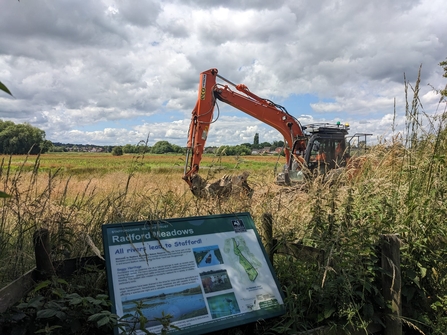
SWT Christine Harding
29 May 2024 - Public Information Event and plan details
Maps and Photos from the Community Information Event - click the file to download
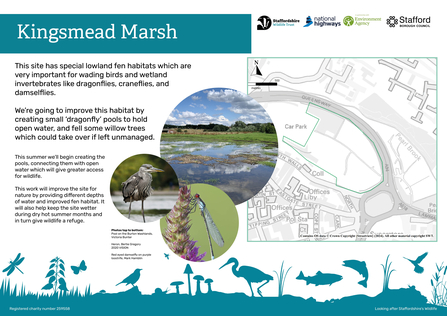
SWT, example of one of the info boards
The Stafford Brooks Project Team at SWT display plans for the first round of project conservation works on eight key sites at Stafford Library. The boards are supplied in a downloadable PDF above.
Kingsmead Marsh
This site has special lowland fen habitats which are very important for wading birds and wetland invertebrates like dragonflies, craneflies, and damselflies. We’re going to improve this habitat by creating small ‘dragonfly’ pools to hold open water, and fell some willow trees which could take over if left unmanaged.
This summer we’ll begin creating the pools, connecting them with open water which will give greater access for wildlife. This work will improve the site for nature by providing different depths of water and improved fen habitat. It will also help keep the site wetter during dry hot summer months and in turn give wildlife a refuge.
Kingston Pool Covert (South)
We will work to transform the grassland on the south side of the covert into a lowland meadow with a
wider variety of wildflowers which will attract more insects. Right now, this grassland has very little variety, and one species is out competing the rest. By pulling up turf and reseeding we’ll create greater diversity.
This summer we’ll begin work here and we hope to see the first signs of wildflowers in 2025. However, grasslands like this one do typically take around five years to fully establish so it may take time for it to look different.
*The Environment Agency has kindly secured extra funding for improvement works to take place along the Kingston Brook in the nearby woodland. We will share more information on this soon.
Rising Brook
Grassland and wet woodland on this site will be improved to host a variety of new species. To do this we will open up drains to let water pool more naturally. Water quality will improve as water will filter through the woodland. Importantly, the work will increase carbon storage at the site, which is vital to tackling climate change. Where needed, we will plant water-loving trees like native black poplar. This tree provides many benefits for wildlife and we’re working to bolster their numbers in the county as they are at risk of extinction.
This summer we’ll begin work here. Over coming years we’ll start to see some of the benefits but the full results will take several years to develop. Tree planting is best done in autumn and winter when the weather is cooler and wetter, so younger sapplings have a better chance of survival. Native black poplar trees can live for 200 years when healthy.
Radford Meadows
This rough grassland has potential to become a wetland mosaic habitat that holds a lot of water and keeps flooding away from other areas in the community. To achieve this we will excavate wetland pools and block drains to control where water sits. We will also manage aggressive plant species like broad-leaved dock and tufted hair-grass, allowing a wider variety of plant life to thrive. The current conservation grazing we do on this site may need to pause while we undertake work, but will continue again in the future. This summer we’ll begin work here. Wetland establishment is very much dependent upon seasonal rainfall over the next few years.
The Meadows at Queensville
This grassland site already features shallow pools. We’ll make these into more permanent pools, ensuring they are in the best place to hold water on site. We’ll also enhance 5.7 hectares of grassland here, creating wildflower meadows. In summer visitors will be able to enjoy meandering through these meadows on mown pathways, which will be created as part of the site’s seasonal management.
This summer we’ll begin work here and we hope to see the first signs of wildflowers in 2025. However, grasslands like this one do typically take around five years to fully establish so it may take time for it to look different.
Riverside Local Nature Reserve (Fairway)
At Riverside Local Nature Reserve we will reprofile the riverbank, altering where and how the river flows. This will make more open water on site, and create a shallow bank along the river which is good habitat for juvenile fish and invertebrates. This will also help us ensure the wetland onsite is healthy, and is wet all year, but in a more appropriate location on the reserve than it has been previously.
This won’t completely stop flooding if we have more years with record levels of rainfall, but it will help reduce the risk of flooding to areas outside the floodplain. Work starts here in Summer 2024, but nature has her own timeline. It may be several years before we see fully developed results with mature plants established on river banks. Black poplar trees take time to grow, and can live for 200 years when healthy.
Former Littleworth Tennis Courts
This former recreation ground will be getting some care and attention through the project as a pocket park - a little pocket of habitat that acts as a stepping stone for wildlife to move through a larger network of nature. We will remove turf and sow seeds to turn this into lowland meadow, a habitat with a greater variety of wildflower and insect species. Residents will be able to enjoy summer wildflowers like oxeye daisy and common knapweed.
These will also provide a vital food source for pollinators and potentially attract butterflies such as the common blue. Works are starting in Summer 2024, but nature has her own timeline. We expect to see the first signs of wildflowers in 2025, but grasslands such as the one here typically take about five years to fully develop.
Corporation Street
The land previously used as a bowling green on Corporation Street will be turned into vibrant lowland meadow, a habitat with a greater variety of wildflower and insect species. This little pocket park will act as a stepping stone for wildlife to move through a larger network of nature in the urban area.
We will remove existing turf and plant wildflower seed, and we’ll plan an appropriate mowing schedule for the local council so blooms can be enjoyed by local residents and passing people. Works are starting in Summer 2024, but nature has her own timeline. We expect to see the first signs of wildflowers in 2025, but grasslands such as the one here typically take about five years to fully develop.
1 May 2024 - Blog: Crucial Conservation for areas in the Stafford Brooks
After an initial research phase of completing surveys, contacting contractors, and deep diving into work plans, The Stafford Brooks project is ready to start the delivery of conservation works on eight key sites across Stafford. These sites have been identified through the initial research phase as the very best places to receive benefits from this crucial funding contribution from National Highways.
You can read more about the kinds of conservation work you will see in our latest blog.
4 July 2022 Formal Project Launch!
£4.1m scheme to enhance riverways and wildlife habitats announced

Black poplar planting - Stafford brooks - CN Harding
28 January 2021 - Securing funding
Launch of exiting £2.5m rivers scheme in Stafford
A partnership project connecting the town's waterways and wetlands
Stafford Brooks is a partnership project with Staffordshire Wildlife Trust, National Highways, Stafford Borough Council, and The Environment Agency. Working together, this partnership will create havens for wildlife to flourish. It will improve connectivity between habitats creating a nature recovery network and help to alleviate flooding. It will also provide residents better access to their local rivers and green spaces across multiple sites.

Stafford Brooks - Map Sites 1 - 8
National Highways is kindly funding this project with money from their Designated Funds programme which was allocated £936m for Roads Period 2 (2020-2025), is divided into four funding streams aimed at making the biggest difference and delivering lasting benefits: environment and wellbeing, users and communities, safety and congestion and innovation and modernisation.
Stafford Borough Council own many of the sites where works will be taking place and have a vested interest in improving the environment for wildlife and local communities. https://www.staffordbc.gov.uk/
The Environment Agency works to create better places for people and wildlife, and support sustainable development. They have been working with us to help us identify the most suitable sites for improvement across Stafford. https://www.gov.uk/government/organisations/environment-agency








